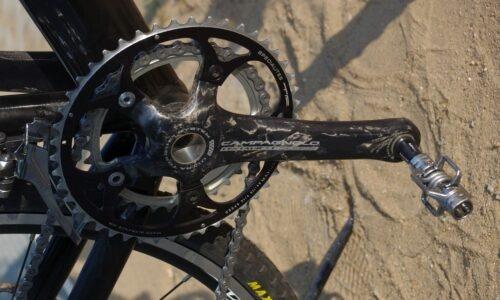Introduction
Mountain biking is a sport that can be rough on both bikes and bodies. Bumps, scraps and bruises are all part of the sport and there is a level of acceptable risk that we acknowledge every time we go out for a ride on our local trails.
It can be argued that the best preventative measure against injury is investing time in improving your riding skills, but even with sharp bike handling skills accidents do happen.
Protective clothing, also known as body armor, is one of the ways by which we can reduce the likelihood of serious injury in the event of taking a spill on the trail. Modern mountain biking body armor comes in various styles with different levels upper body protection, including:
- Back and spine armor: usually a rigid plate of lightweight yet string plastic worn with shoulder straps (or placed inside special sleeves in some modern hydration packs) to offer protection against impacts to the spine, which can be extremely dangerous.
- Chest and torso armor vests: These are usually variants of spine protectors with additional padding added in the chest and torso.
- Short sleeve tees with protection inserts: designed to be worn underneath riding jerseys offering protective padding in key areas, like shoulders, chest and back.
- Full upper body armor suits: These are usually long sleeve upper body suits with a more comprehensive protection for most of the upper body.
Within the disciplines of mountain biking that take place on extreme terrain with an increased risk of injury, body armor adds an element of protection and confidence that even very experienced riders find important. On downhill and endure racing tracks, you will often see riders wearing one of the varieties listed above.
Highly experienced elite racers usually have a preference for types of body armor that protect critical areas while still allowing an unrestricted range of movement. In some races, the organizers may even make certain types of body armor mandatory, like spine protectors.
In this article we look at some of the best body armor accessories for mountain biking available in 2021. We also offer a few tips on how to pick the best body armor for how and where you ride your mountain bike.
Back and Spine Protectors
1. POC VPD System Back Protector
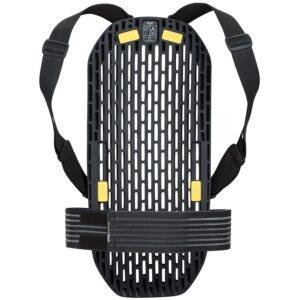
This minimal back protector from POC has a singular focus: spine protection. It is essentially an ergonomic pre-shaped piece of strong yet lightweight plastic that POC calls Visco-Elastic Polymer Dough (hence the VPD in the name).
Many back protectors are bulky and cumbersome, but the VPD System back protector seems to strike a good balance between good coverage and a lightweight and low-profile design. Two light shoulder straps and another two at the waist secure it where it needs to be. It comes in three sizes.
2. POC Spine VPD Air Backpack Vest

Another offering from POC’s excellent VPD Air line of body armor is the POC Spine VPD Air backpack vest. The VPD Backpack vest manages to not only offer good spine protection similar to its VPD System protector featured earlier, but also add some hydration and storage capabilities. The VPD Air vest can carry a 3L hydration bladder, and has some room for tools and spares.
3. CamelBak K.U.D.U. Protector 10 7 L Hydration Pack

If you need more gear carrying features and don’t want to wear a backpack over a spine protector this one might be for you, as it integrates a full-size mountain biking hydration apck with a back protector plate.
The CamelBak K.U.D.U. hydration pack has an integrated full-back CE Level II protector panel which helps to absorb impacts to your back in a crash. It also has integrated armor carrying straps that allows you to stow knee and elbow pads if you’d rather not wear them during the climbing sections of your rides. It comes with a 3-liter CRUX hydration bladder.
Chest and Torso Armor
1. Troy Lee Designs Rockfight CE Chest Protector

For days in the bike park and for lift-assisted riding, you will want a bit more protection than what pairs of knee and elbow guards will offer. The TLD Rockfight chest protector has D30 inserts that offer excellent impact absorption. The Rockfight comes in two sizes with hook-and-loop straps on the shoulders and buckled straps at the waist to allow you to further dial in the fit.
2. Fox Racing Race Subframe
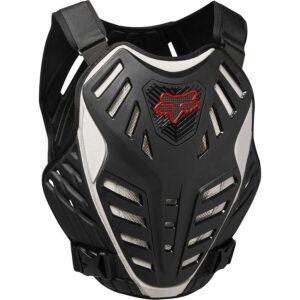
The Fox Racing Race Subframe is a torso guard with spinal armor designed to be worn unobtrusively under your riding clothing. The back guard uses D30 foam while a hard plastic insert offers coverage for the chest. The shoulder straps are flat and low profile to avoid bulkiness and the foam is vented for breathability. The Race Subframe is designed for a slim fit to fit discreetly under your riding jersey.
3. Leatt 4.5 Chest Protector

The Leatt 4.5 chest protector offers a multi-plate articulating design. The chest, back and flank armor uses a two-layer construction with Leatt 3DF foam for impact absorption below a layer of High Density Poly Ethylene outer hard-shell for additional protection.
The front and rear armor plates are removable to allow for various options for wearing with a neck brace.
Short Sleeve Armor Tees
1. Leatt 3DF AirFit Lite Body T-Shirt

This armor t-shirt from protection specialists Leatt offers all around upper body coverage in a comfortable t-shirt. The AirFit Lite has chest and back protectors with elastic mesh straps for easy fit adjustment.
The t-shirt itself uses a light mesh fabric with good breathability which makes it suitable for use in warm weather conditions. A sturdy zipper runs along one side and makes it easy to put on and take off the AirFit Lite armor t-shirt.
2. Dainese Trail Skins Pro Tee
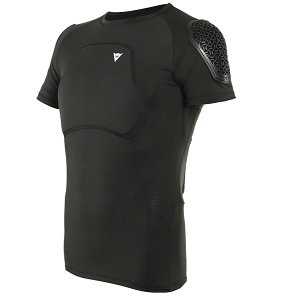
Another excellent upper body protector in t-shirt style is the Dainese Trail Skins Pro Tee. It comes with removable protective inserts that cover the shoulders, back, and chest.
The highly breathable fabric offers ample ventilation and won’t feel cumbersome worn underneath your riding jersey. One feature I like about the Dainese Trail Skins Pro, which I have not seen on other similar products, is that it has back pockets!
3. IXS Carve Upper Body Protective Jersey

The IXS Carve upper body protective jersey is a light and slim fit armor shirt with protective foam inserts in key areas such as back, chest, ribs and shoulders.
The Carve jersey has a lightweight, moisture-wicking and breathable fabric and a full stretchable YKK zipper for to improve fit and comfort. It is one of the few armor jerseys that is offered on both adult and kids sizes.
Full Armor Suits
1. Dainese Rhyolite 2 Safety Jacket

The Rhyolite 2 Safety Jacket by Dianese offers more comprehensive upper body protection for days of high speed riding at the DH track or the bike park. Dainese uses flexible padding that wraps all around the torso from the chest to the back, and there is additional memory foam padding on the ribs and upper chest for enhanced impact absorption.
The side panels are breathable and the full sleeves are removable for hot summer days when you don’t need the full coverage that this jacket offers.
2. Troy Lee Designs 7855 Heavyweight Long-Sleeve Protection Shirt

This long sleeve armor shirt from Troy Lee Designs offers full coverage with strategically placed armor panels. The wide neck opening is designed to enure compatibility with neck braces, and the armor panels are removable, which allows you to customize the protection level for the type of riding you plan on doing.
3. Fox Racing Titan Sport Jacket
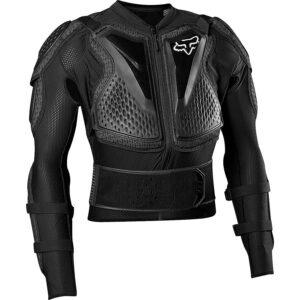
The Titan Sport Jacket from Fox Racing combines a stretchy and highly breathable mech main fabric with high-impact plastic panels located on the back, chest, shoulders, and elbows, providing the coverage and protection needed for DH racing or bike park laps.
The back protector is removable for days you don’t need it, and the full zip closure makes it easy to put on and take off.
Things to consider before buying your mountain bike body armor
Choose the type of body armor to match your riding style
If most of your rides are on groomed trails with no massive drops, jumps or technical features, then you will want to prioritize unrestricted range of movement and all-day comfort. For this type of riding you can compromise a little on protection and coverage for the sake of lighter and more minimal pads.
Light armor tees with minimal foam padding would be great for this kind of riding. Conversely, if you are an enduro or downhill racer, then enhanced protection and coverage will take priority over low weight or less bulkiness.
Materials and fabrics
The basic anatomy of a piece of protective clothing is comprised of the material that goes against your skin as well as some kind of protective foam, plastic or other impact-resistant material. Fit adjustment is usually done by means of hook-and-loop straps, zippers or plastic buckles (or a combination of those things). Similar to any other items of clothing, how body armor fits will come down to personal preference, and it is always best to try before you buy.
Conclusion
Wearing body armor can help protect against serious injuries as well as increase your confidence on the mountain bike especially when riding challenging trails. What you should remember is that body armor, no matter how good it is, will never offer complete protection against injury, and that you should always ride within the boundaries of your skills.
How much or how little body armor you wish to wear is a matter of personal preference, and will depend on the type of trails you ride and the style of riding you do.
Whatever the type of protective clothing you choose to wear, ensure that you pick body armor that not only offers good coverage and protection, but also fits you well and allows you unrestricted movement on the bike. There is no point in ill-fitting body armor that will discourage you to wear because it’s too uncomfortable!

Hani Morsi is a seasoned multi-discipline cyclist with a particular liking for mountain and gravel bikes. Hani is also a mountain bike coach, trail builder and experienced bike mechanic.

